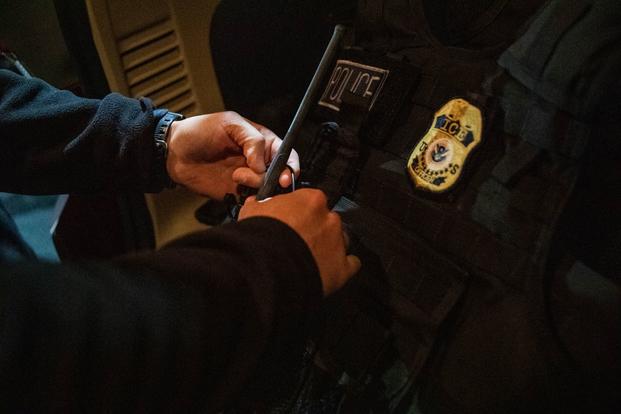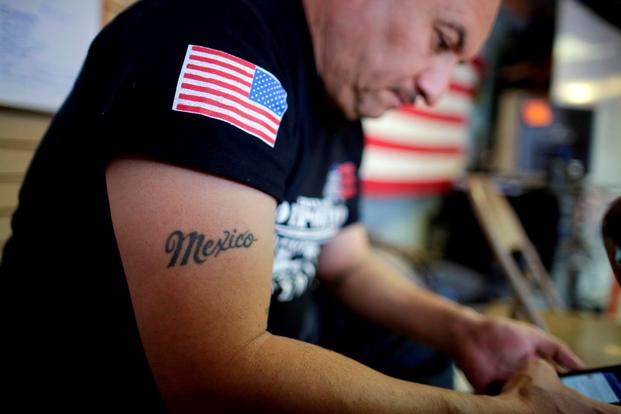SAN ANTONIO — Marcelino Ramos said he joined the U.S. Marines Corps at 17 because he felt a duty to serve and because a recruiter in a pressed-blue uniform promised him citizenship. Ramos, now 54, had no idea that the country he swore to protect would deport him.
Ramos went on to serve in the Gulf War and after he completed four years of service, he returned to his family and home in Texas.
Ramos, who has PTSD, was arrested for a felony conviction that stemmed from a domestic violence incident in 2009. He said he tried to fight the charges but his public defender advised him to take a two-year plea deal.
But Ramos didn’t realize his conviction would put him on the radar of Immigration and Customs Enforcement, which eventually found him and deported him because he was never granted citizenship.
Hundreds, if not thousands, of foreign-born U.S. military veterans convicted of crimes have been deported. Despite President Joe Biden’s promise to bring them back, only about 50 veterans, including Ramos, have returned under a 2021 executive order.
Advocates and immigration attorneys say Biden’s policy is a temporary fix that fails to find deported veterans and protect those still living in the U.S. from being forced out and possibly killed or recruited by criminal organizations looking to profit from their skill sets.
“Being deported is a death sentence to any U.S. veteran,” Ramos said. “This is my home, my family and everyone I love is here. I can’t go back.”
A Failed System
President Biden signed an executive order in February 2021 to immediately conduct a review of policies and practices to ensure that all eligible current and former noncitizen service members and their immediate families can remain in or return to the U.S. under a humanitarian parole.
The order created the Immigrant Military Members and Veterans Initiative, which aims to consolidate all federal resources available to support noncitizen veterans, active service members and their families.
As of June 21, 2022, the IMMVI team had received 143 inquiries from veterans living outside the U.S. due to removal, or other issues that restrict their return, according to Congressional testimony from Debra Rogers, director of the initiative.
Many of the veterans who received humanitarian parole, such as Ramos, have been threatened by gangs and cartels that want them to help train their members, according to Danitza James, chief of policy and legislation at Repatriate Our Patriots, a non-profit that provides free services to deported veterans on both sides of the U.S.-México border.
About a dozen of the 50 or so deported veterans that have received humanitarian parole have been able to gain citizenship and stay in the U.S., according to James. The rest, like Ramos, remain in limbo.
Humanitarian parole is a discretionary visa granted to individuals who are inadmissible to enter the U.S. and remain for a temporary period.

After being deported in 2011, Ramos crossed back illegally to the U.S. and started a new life in San Antonio where he met his wife Frances Riojas. He was deported again in 2016 after landing in a hospital with a stab wound he suffered during a fight.
In November, after six years in México, Ramos was allowed to return home to his wife in San Antonio for one year. His attorney filed for his citizenship but it could be months before he knows if he’s been approved.
“I’m trying my best to stay busy and I’m getting the medical help I need with my PTSD but it’s a heavy burden to know that I might have to go back,” Ramos said. “Every day I’m grateful that I get to be home with my wife and that I get to spend some time with my dad and my daughter.”
An Immeasurable Problem
Danitza James is the chief of policy and legislation at Repatriate Our Patriots, a non-profit that provides free services to deported veterans on both sides of the U.S.-México border.
Repatriate Our Patriots has helped hundreds of deported veterans in México find a safe place to live, including Ramos. But even after Biden’s order, organizations like this one are the only one’s looking for deported veterans, according to James.
“It should be the U.S. government’s responsibility to know how many veterans they’ve deported,” said James, an army combat veteran. “But I think it’s not in their interest because then [U.S. Citizenship and Immigration Service] officials will need to explain, ‘Why were you not following the policies set in place? Why did you deport these veterans?”
U.S. Customs and Border Protection, USCIS and ICE are the three government agencies responsible for veterans being deported, but ICE is the only one that had a policy in place to identify veterans before 2022.
But from 2013-2018 ICE did not consistently follow its own policies, failing to maintain complete electronic records on these veterans. As a result, ICE does not know how many veterans have been placed in removal proceedings or removed, according to a 2019 report by the U.S. Government Accountability Office, the investigative arm of Congress
In February 2022, all three agencies issued supplemental policy guidance to help train officers to identify former military members and expedite requests for parole so they can return.
Jennie Pasquarella, director of immigrant rights for the ACLU of Southern California said she’s not sure how well immigration officials are adhering to the new policy but she’s seen fewer veterans placed in removal proceedings since it was put in place.
In 2016, the ACLU released the first comprehensive report explaining why veterans were being deported. The report, “Discharged then Discarded: How U.S. veterans are banished by the country they swore to protect,” looked at 59 cases of veterans who had been deported or were in removal proceedings.
Many were decorated combat veterans who sustained physical wounds and emotional trauma in conflicts going back to the war in Vietnam. Some were kicked out of the country for minor offenses that resulted in little if any incarceration, according to the report.
The report traces many of the deportations they studied to the Illegal Immigration Reform and Immigration Responsibility Act of 1996, which expanded the spectrum of deportable offenses to include misdemeanors. Many believed they became citizens by nature of their service and oath — some were told as much by their recruiters — and were never informed otherwise, according to the report.
Pasquarella said veterans were being deported long before the act was passed but she thinks it exacerbated the problem. And there’s no evidence to back this because no one knows how many veterans have been deported.
“There’s no way to recreate those numbers so it’s all anecdotal,” Pasquarella said. “It could be 1,000 or it could be 20,000.”
Deportations Continue
Margaret Stock, retired lieutenant colonel with the U.S. Army Reserve and managing attorney at the Cascadia Cross Border Law Group in Anchorage, Alaska, has represented dozens of veterans facing deportation, including some as early as last year.
Stock said deportations of veterans continue to happen because the process for service members to become naturalized is more difficult than it is for those outside the military.
As part of their citizenship application, service members are required to obtain a certified letter from a high ranking official who they often don’t have access to as new recruits. Those that successfully apply, often end up waiting indefinitely when their documents are lost in the mail or their notices of eligibility for citizenship never reach them through their deployments and transfers, according to immigration attorneys.
Service members, like all applicants, must be permanent U.S. residents and able to pass an in-person naturalization interview.
USCIS cut the number of its international offices from 23 in 20 countries to just four offices during the Trump administration, making it harder for deployed service members to apply and complete the interview, according to the testimony of U.S. Rep. Jerry Nadler (D-NY) during a 2019 House Judiciary subcommittee hearing on deported veterans.
In 2018, USCIS also terminated the Naturalization at Basic Training Initiative, which provided onsite immigration resources and staff to support recruits beginning the naturalization process and allowed non-citizen enlistees the chance to naturalize when they graduated from basic training.
USCIS did not respond to multiple requests for comment.
“This is a problem that could be fixed by the executive branch of the government but they don’t have the willpower,” Stock said. “The president made statements and said: ‘I’m going to do this and do that’ but then he didn’t follow it up with actually putting people in place and empowering them to fix the problem.”











